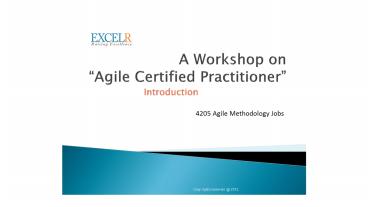PMI ACP certification - PowerPoint PPT Presentation
Title:
PMI ACP certification
Description:
ExcelR is one of the best training institutes that built careers of thousands of professionals .ExcelR has 94% placement record in various MNCs in India and abroad – PowerPoint PPT presentation
Number of Views:367
Title: PMI ACP certification
1
Copy rights reserved. _at_ 2013.
2
? Exam Eligibility? Exam Pattern? Pre
requisites
? Content Distribution? Tools and Techniques
? Domains and Tasks for Agile Certification
(PMI-ACP) Agile Certified
Practitioner
3
General PM Agile PM
Category Education PM education
Experience Experience
21 contactHours from REP
1500 hrs(Last 2 Years)
One Bachelors
2000 hrs
1500 hrs(Last 2 Years)
High 21 contact
Two
4000 hrs
School Hours from REP
(PMI-ACP) Agile Certified Practitioner
4
? No of Questions 120? Duration 3 hours
Part
Percentage
Agile Tools and Techniques
50
Agile Knowledge and Skills
50
(PMI-ACP) Agile Certified Practitioner
5
(PMI-ACP) Agile Certified Practitioner
6
(PMI-ACP) Agile Certified Practitioner
7
(PMI-ACP) Agile Certified Practitioner
8
(PMI-ACP) Agile Certified Practitioner
9
Group of software development methods based on
Iterative and incrementaldevelopment
Requirements and solutions evolve through
collaboration between self-organizing,Cross-funct
ional teams
Promotes adaptive planning, evolutionary
development and delivery. Time-boxediterative
approach
Encourages rapid and flexible response to change
It is a conceptual framework that promotes
foreseen interactions throughout thedevelopment
cycle. The Agile Manifesto introduced the term in
2001.
(PMI-ACP) Agile Certified
Practitioner
10
In February 2001, 17 software developersmet to
discuss lightweight developmentmethods.
They published the Agile Manifesto forSoftware
Development to define theapproach now known as
agile
software development
(PMI-ACP) Agile Certified Practitioner
11
Lightweight agile software development methods
evolved in the mid-1990sas a reaction against
the Heavyweight waterfall-oriented methods.
1994
1995
1996
1997
RUP
Scrum, DSDM
ASD, FDD
Crystal Clear, XP
These are now collectively referred to as agile
methodologies
(PMI-ACP) Agile Certified
Practitioner
12
Agile practices are gaining in popularity
Survey Respondent
26
Forrester Study shows 74 of respondentsclaim a
mature adoption of agile (How Agile isYour
Organization?, April 30,2013)
Claim
Mature
74
Adoption
Agile provides a great way for software
development organizations to deliver
qualitysoftware in a predictable fashion
Many organizations use a combination of agile and
waterfall techniques depending ongoals.
12
13
Give me all requirements, otherwise it will cost
you!
13
14
Traditional Software Development Agile Software
Development
Requirements are analyzedArchitecture and Design
are createdRequirements are implemented,tested
and delivered
Requirements are translated into UserStories and
become the product backlog
Usable chunks (high Value Stories) ofsoftware
are developed in short periodsof time (sprints,
iterations, etc.)
Months (or longer) occur before usablesoftware
for customer to evaluate
Customer works with the team andreviews software
regularly
Priorities may shift from iteration to
iterationAgile teams expect and embrace change
14
15
Traditional Project Management
Agile Project Management
Planning given importance
Execution given importance than planning
Time and cost are fixed. Scope is derived
Scope is fixed. Time and cost are derived
Delivering within triple constraint is a success
Delivering business value is the success of the
project
Scope once fixed follows change control Process
and customer charged for every change
Scope is flexible and change is accommodative
Project manager controls the project and
Controls the team
Team controls the project and team is self
organizing to take care of the project
Incremental product is delivered to Customer
frequently
Documents are interim deliverables and Final
product is delivered at the end of the phase
(PMI-ACP) Agile Certified Practitioner
16
CONTACT US
www.excelr.com enquiry_at_excelr.com Toll FREE
1800-212-2120 (India) 0044-203-514-6638
(UK) 006-128-520-3240 (Australia) 001-844-392-357
1 (USA) 2348181496946 (Nigeria)
THANK YOU































